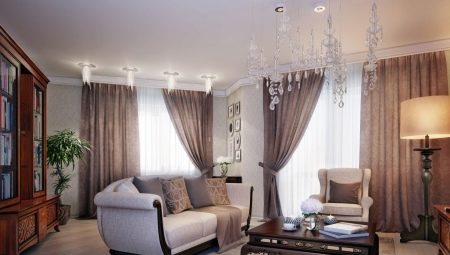Buying curtains for the living room is one of the most important stages in the design of the interior of the hall, the final attractiveness of the room largely depends on it. When choosing, you need to take into account many different nuances - from the color and style of curtains to the material used, sewing technology and the method of hanging on the ledge.
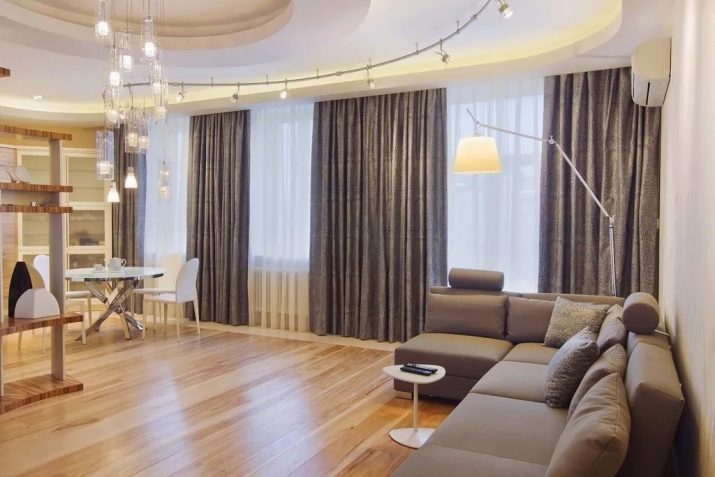
Basic selection rules
The hall is the main room in any house, it is here that we rest after a hard day, we communicate with members of our family, meet friends and relatives. That is why the interior of the living room should be thoughtful, stylish and harmonious - so that it reigned in an atmosphere of warmth and real comfort. Nowadays, the textile industry offers the widest selection of curtains - it is not surprising that you can get lost in such a variety.
So that curtains do not become an extra element of decor, but rather emphasize the selected style of the living room, it is necessary to take into account the footage of the room, the level of illumination, furniture and the general color scheme of the interior. So, if the room is spacious - here you can pick up any curtains, both expensive imperial textiles and Japanese curtains will harmoniously look. And if the room is small, then emphasis is better placed on the laconic design of the window - there is no place for bulky draperies and a pile of decor elements.
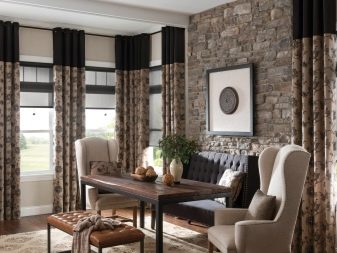
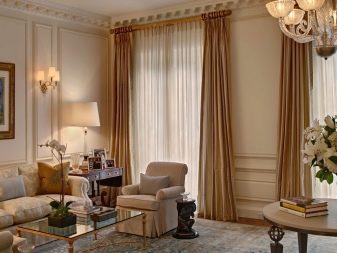
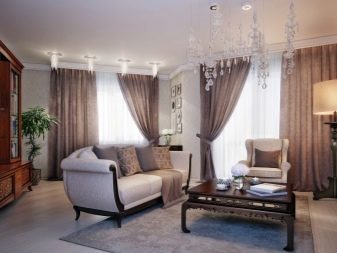
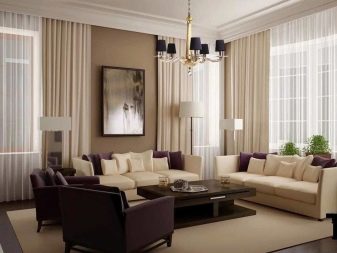
Using curtains, you can visually change the height of the window, for example, using direct curtains from the ceiling to the floor makes the window longer, especially if you chose mint, turquoise or blue color textiles.
To expand the window, it is worth giving preference to air models hung over the entire length of the cornice. On the sunny side, blackout curtains will be the best option. And if the windows face the north side, light-transmitting materials will be a good solution. Keep in mind, the style of the curtains should not contrast with the overall interior design, for example, if your room is decorated in baroque, country-style curtains will be completely inappropriate.
Draperies and wallpapers in the interior should be harmoniously combined - this does not mean at all that they should be chosen monophonic, but it is advisable to pick up these elements in a common color scheme. The canvas itself, from which the curtains are sewn, should be combined in texture with the upholstery of upholstered furniture.
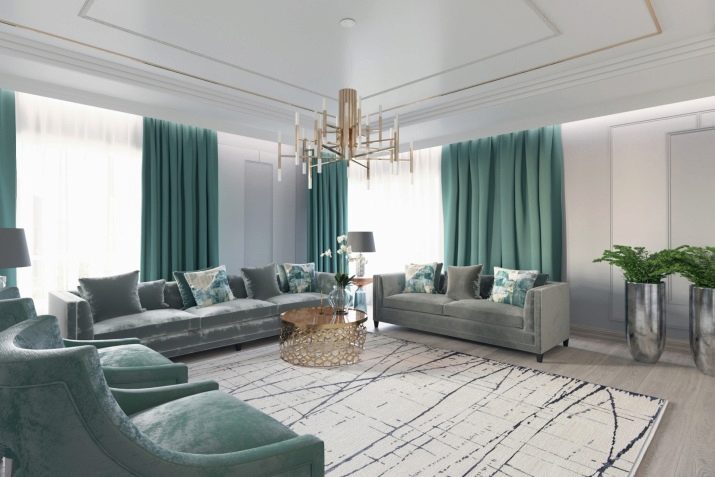
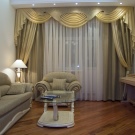
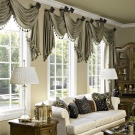

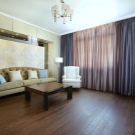
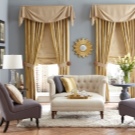
How to choose a style and length?
Let us dwell in more detail on some aspects of selecting the length and style of curtains. Many forget that window textiles need regular cleaning - and this means that the curtains should be easily removed from the cornice, washed well and ironed easily.
Too bulky draperies with an abundance of decor elements are quite difficult to maintain, such products are best washed in dry cleaning. If you are not ready to constantly resort to such services, immediately abandon such draperies. Shortened curtains look best in the kitchen and in workrooms. However, it is allowed to use Roman and roller blinds in the hall, but only as additional curtains, while the central role here should be given to semi-translucent airy matter.
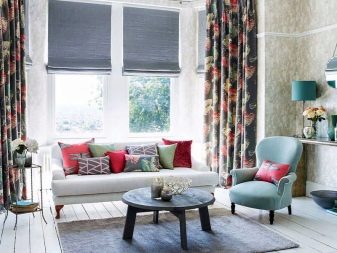
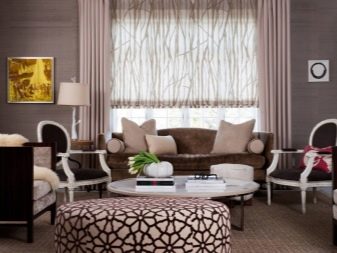
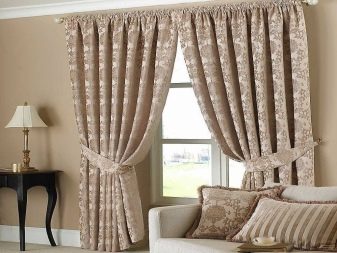
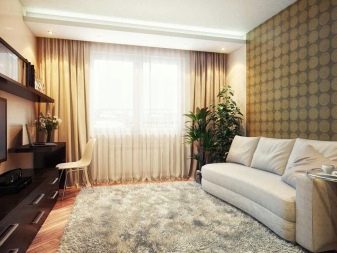
The most successful choice for the living room will be fabrics that will give pleasure to all households.
If your family members like folds, ruffles and lace - it is worth staying on Austrian and French models, for romantics the best choice is London or Italian curtains, and for ascetics or lovers of a minimalist style in the interior, Japanese curtains can be recommended.
Curtains for the hall are often complemented by lambrequins and bandos. The first ones are drapery materials fixed on the top of the structure, and the second ones are a kind of lambrequin, cut out and hard-fixed canvas. Regardless of your own preferences special attention should be paid to the dimensions of the room. So, in small rooms with bulky draperies it will be difficult to be, while spacious rooms do not dictate any restrictions on the shape and design of the curtains.
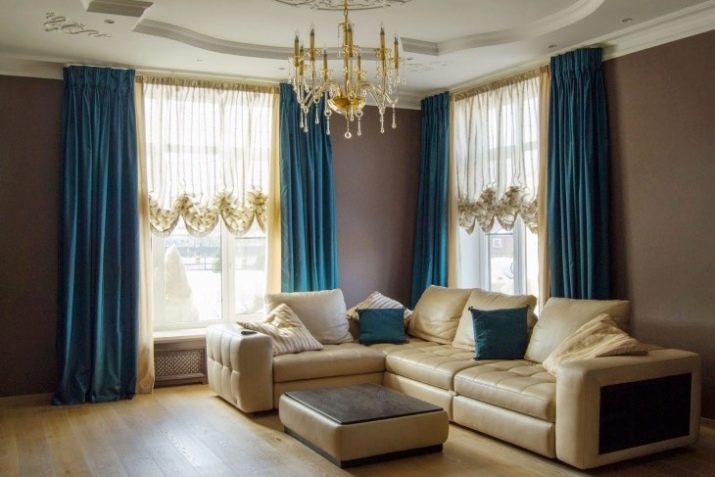

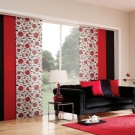
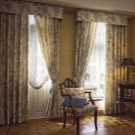
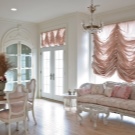
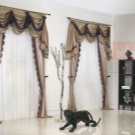
Determined with the fabric
The style of the curtains, the method of their installation, and the stylistic design of the interior largely depend on the choice of the canvas. It should be noted that both light and dense fabrics can harmoniously look in the living room - the choice depends only on the ideas of the designer. If the hall is located on the ground floor or there is an office or residential building nearby, then you cannot do without dense materials - you will have to close your hall from prying eyes, thus ensuring a comfortable and safe stay in the living room.
Light-tight webs will also be the best choice for rooms facing the sunny side. Lightweight fabrics are optimal if you do not need to close the window - for example, in a private house. In smaller rooms it is also better to give preference to airy materials, as dense draperies visually hide the space.
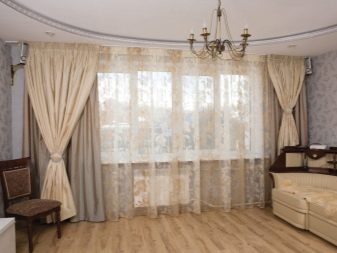
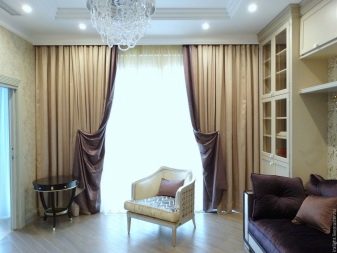
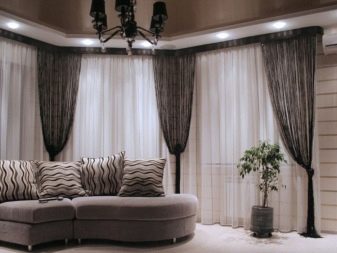
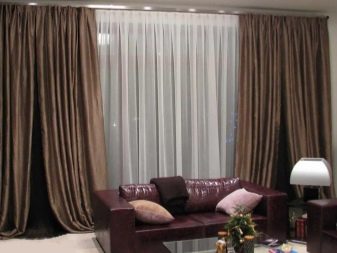
The best option for the living room will be a combination of tulle and drapes. Of the natural materials, cotton, linen, wool, and silk or velvet are most often used. Artificial fabrics should not be neglected, since their choice is much wider, all types of fabric have their advantages and disadvantages. Natural materials are environmentally friendly, they are pleasant to the touch, but they wrinkle faster and are more difficult to drape, and caring for them can be quite laborious.
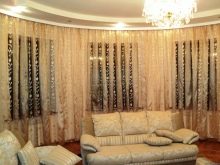
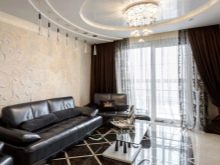
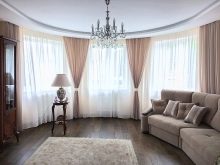
Synthetic fabrics in stores there are a wide variety of colors and textures, so you can create real masterpieces of indoor textiles from them. In addition, they are easier to clean, and serve several times longer than natural ones. Another undoubted advantage of synthetics is that such curtains practically do not fade under the influence of sunlight and do not wash, which means that even after a few years your curtains will look like new.
When choosing a material, it is also necessary to take into account the rigidity of matter - the necessary volume and folds are obtained only when using hard paintings, for example, organza. Such materials emphasize the clarity of the lines of the living room and its structure. Soft materials such as tulle and chiffon contribute to the creation of flowing draperies and emphasize the classic and romantic styles in the design of the premises.

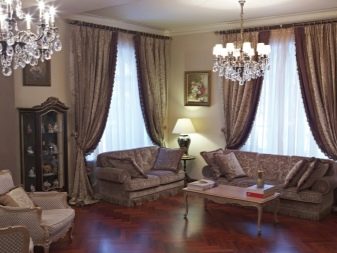
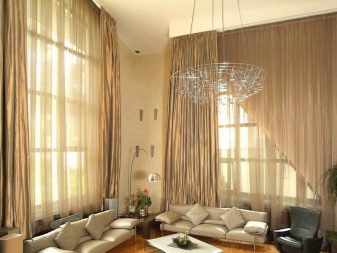
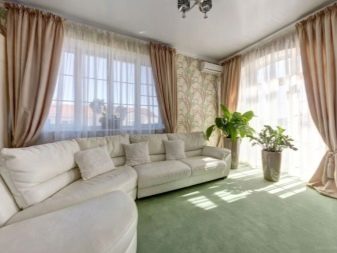
What color is suitable for the interior?
When choosing a color for curtains, it is necessary to take into account the general tint solution of the interior. Contrast combinations look very impressive - in this case, curtains of saturated bright colors are selected to a neutral shade of walls and furniture. Such a tandem enlivens the most boring room. Usually contrasting combinations are used in modern rooms decorated in the style of minimalism, hi-tech or fusion - black and white combinations are most in demand. To match the curtains, you need to choose carpets, sofa cushions, rugs or decorative elements on the walls.
In small interiors, it is advisable to use light curtains that match the basic tone of the wallpaper or other wall decoration. Here it is necessary to maintain the airiness of the room and lightness - the monochrome color scheme is the best fit for this task.

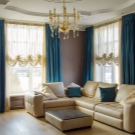
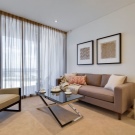
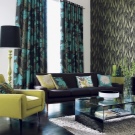

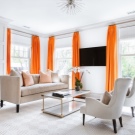
Styles
The design of the window in the hall should fully comply with the style of the interior as a whole.
Classic
This style involves the use of opaque heavy canvases, which are usually combined with airy, light and transparent materials. Classical-style curtains are decorated with lambrequins, as well as rich braid and cords.
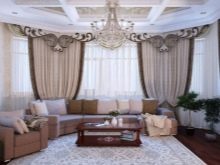
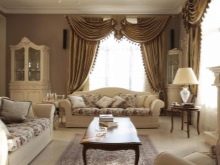
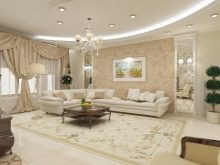
Modern style
When decorating rooms in an inflorescence with the principles of minimalism or hi-tech, it is desirable to give preference to simple and transparent materials, canvases with an unobtrusive metallic sheen are allowed. How the alternative looks good expensive fabric with laser cut. Decor elements in ultra-modern styles are not recommended.
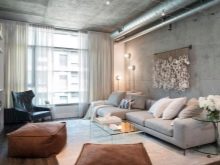
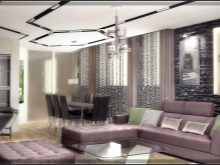
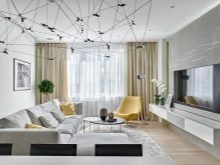
Provence
Here, natural fabrics with simple unobtrusive patterns (cells, stripes, as well as floral ornaments) will be optimal.
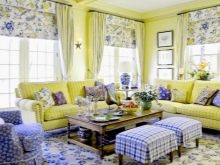
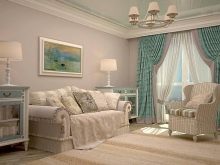
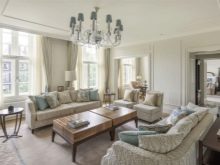
Empire
This design will be appropriate dense and warm fabrics in combination with light flowing tulle. Material must be expensive: satin, silk, brocade, velvet or velor.

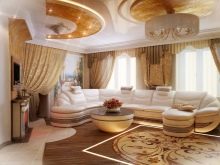
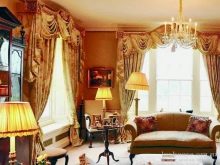
Baroque
In this style, complex fabrics are used for window decoration, always with fittings. Such curtains are usually decorated with fringe, frills and lace.

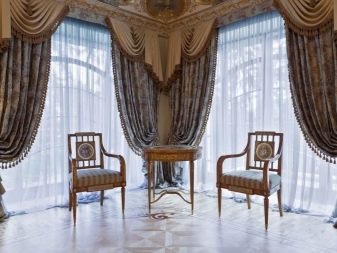
Designer Tips
Observing all the basic rules for choosing shades, styles and sizes of curtains, do not forget about fashion trends in the field of interior decoration. In the last decade, such areas as the absolute favorite in the design of living rooms were: minimalism, Scandinavian and hi-tech - they do not accept brightness, excessive splendor and an abundance of decorative elements. However, not so long ago, a completely opposite trend was outlined, and decisions involving juicy colors and the creation of artistic compositions from curtains came into fashion again.
As before, the Roman and rolled curtains from natural paintings with the most sophisticated patterns have not lost their relevance. Harmoniously look in an interior rolled bamboo cloths.
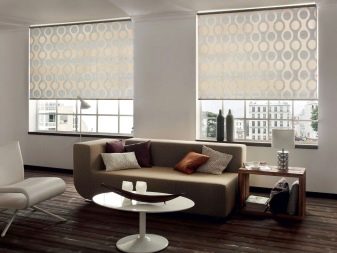
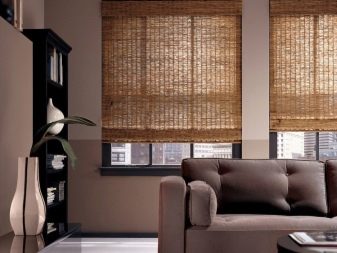
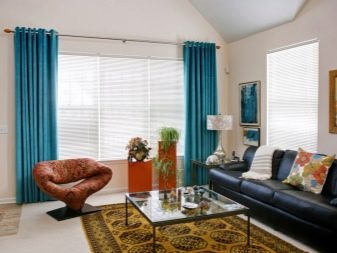
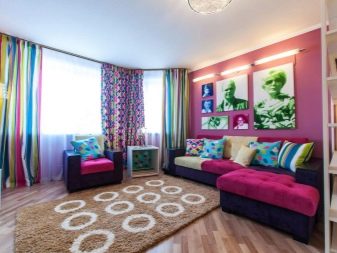
Curtains with patterns in the painting technique, as well as with irregular geometric prints, for example, with ovals, zigzags and broken lines, are in great demand. Do not forget about the ombre curtains.This technique involves smooth transitions from one shade to another on the same canvas. To create truly light and stylish interiors, watercolors with blurry colors are used - they invariably fill the atmosphere with fun and ease.
The originality, originality and style conquered the layering - it is present both in the clothes of a modern person and in the design of windows. A tandem of several paintings of different colors and textures creates beautiful stylish contrasts that make the window a central design element of the living room.
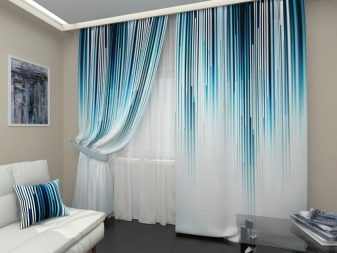
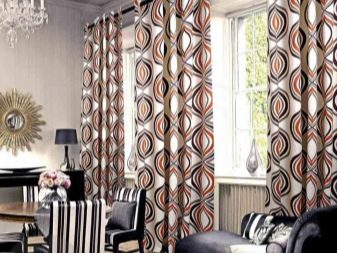
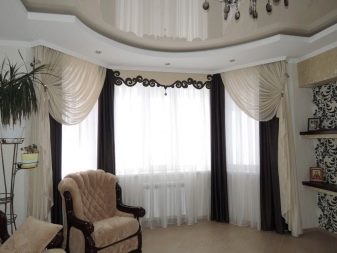
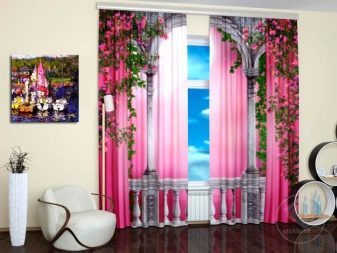
See how to choose curtains in the next video.
